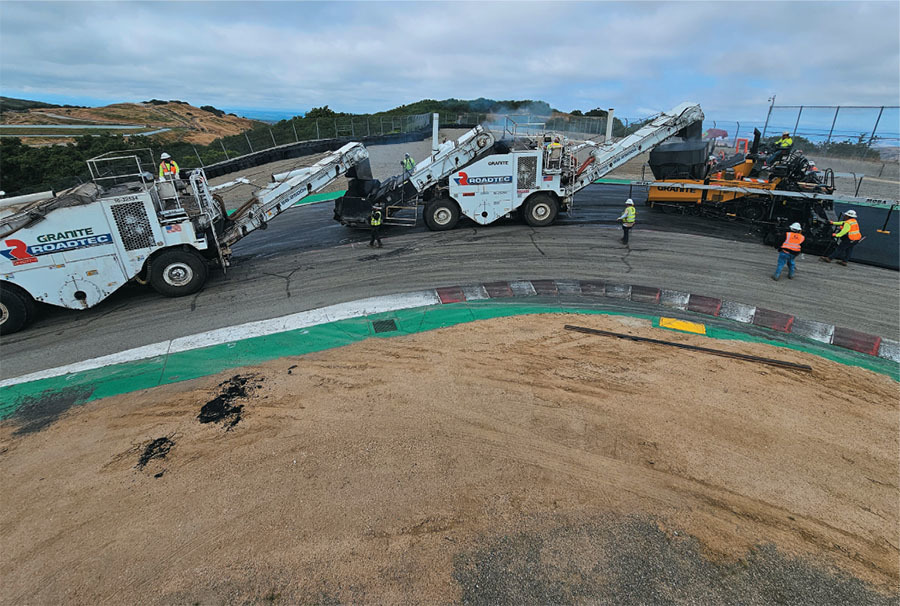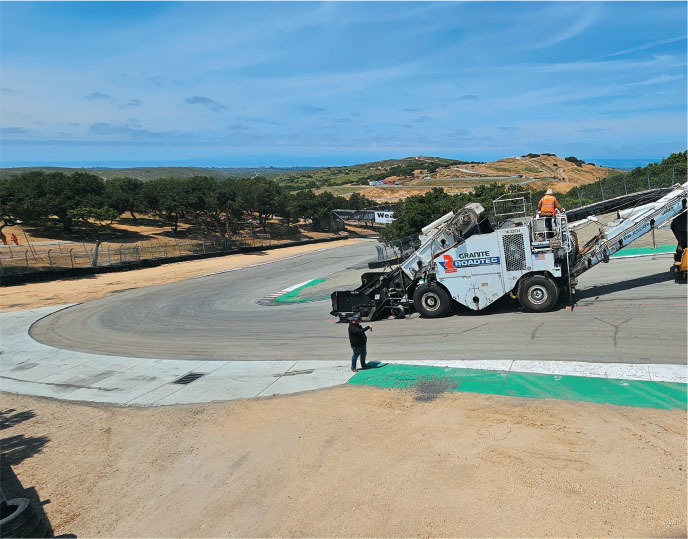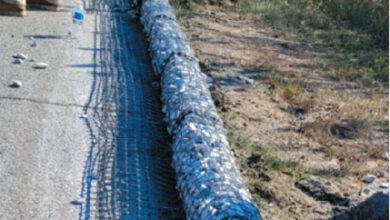Granite & AMS Repave Laguna Seca Racetrack in CA

When a racetrack is known for a ‘corkscrew,’ drivers, spectators, and pavers know they are in for a ride. WeatherTech Raceway Laguna Seca reopened for business in July after an eight-month renovation that cost around $20 million.
The raceway, located in a semi-arid area of Monterey County, California, is owned by the county.
In 1957 the Sports Car Racing Association of the Monterey Peninsula began fundraising and collected some $125,000 for the construction of the track. Granite Construction was selected as the contractor to build the track. Two months after beginning, the track was completed and hosted the first event with 100 entries and 35,000 spectators.
Today, nearly 70 years later, the track is managed by Laguna Seca Volunteer Association (LSVA) and A&D Narigi but Granite is still the frequent choice to handle the paving. Oral history has it that when the track was originally being built, the Granite crew was breaking for lunch. One of the supervisors told a worker to get down the hill with the bulldozer any way he could. And the famous corkscrew was born.
The track is just over 2.2 miles long with a steep elevation change from the lowest point to the top of the corkscrew. At the peak of the corkscrew, one can look out to the Santa Lucia mountains and across Monterey Bay. Of course, a driver would be keeping his eyes on the road.
Drivers describe the sensation coming out of the corkscrew as like driving off a six-story building. Looking over the front of their cars, drivers cannot see the bottom of the road. Knowing that it is there, of course, drivers accelerate into the drop at a 50 percent grade.
“Creating the right mix for the track required a delicate balancing act. “
“The track is just over 2.2 miles long with a steep elevation change from the lowest point to the top of the corkscrew.” The corkscrew is challenging for pavers as well. Jim Hovde, project manager for Granite, surveyed the job with some trepidation. “We are very safety conscious at Granite, and we didn’t want to get into a situation where a dump truck would turn over because of the extreme grade. So, we were very careful in our planning for the job. It pushed our capability in almost every way.”
After milling 2 inches off the track, Granite began working on some subgrade repairs. Normally this would be simple, but the historic rains that washed over most of California slowed many paving activities. “We had anticipated about 20 subgrade repair locations and ended up completing over 85 dig outs to repair soft areas,” said Hovde. “It seemed like as soon as we would repair one area, another one would show up right next to it.”
“The track is just over 2.2 miles long with a steep elevation change from the lowest point to the top of the corkscrew.”
As part of the operation, Granite demolished the overhead bridge and built a new one. This is an iconic structure for the track where spectators walk across the bridge with racers whizzing beneath. Granite had just finished demolishing the bridge when the first of a dozen atmospheric river events struck. The repeated rains resulted in a state of emergency in some 20 California counties.
In most paving operations, the Granite team would do several lifts with the paver. However, this circumstance called for a single lift with small corrections to be done on the spot. The smoothness requirements for the job were tight.
Racetracks must be super smooth for vehicles traveling 100-plus mph. A single bump could be disastrous.
“One of the highlights was the performance of ABSL, a local milling contractor,” said Hovde. “They had a profilograph on site all the time and were continually grinding and grading so that the track would be as smooth as possible.”
The Granite team paved the track in echelon, using two pavers with two crews operating in tandem. This approach enhanced smoothness at the rest of the track. The corkscrew was handled in two passes with the crews achieving remarkable smoothness numbers.
Another unique challenge for the crew was the requirement for an unusually stiff mix. Granite’s asphalt plant in Salinas handled the production of the specialty mix. The paving required 7,500 tons of asphalt. The asphalt was 9.5 mm nominal aggregate in a polymer-modified mix.
In addition to Granite’s partnership with the county, Granite worked closely with Brian Prowell of Advanced Materials Services (AMS), who has handled engineering and paving at many racetracks. “Granite did a good job in the paving and produced a good bond between layers. That is especially important since the pavement must be one that can take the sheer stresses that the race cars produce.”
Creating the right mix for the track required a delicate balancing act. “Drivers want a pavement that their tires can grip. As engineers, we’re concerned about the longevity of the track too. Sometimes we don’t get the balance quite right,” said Prowell.
“Racetracks must be super smooth for vehicles traveling 100-plus mph. A single bump could be disastrous.”
“We needed a track with a binder that has the right softening point,” Prowell explained. “The softening point is where the binder changes from a semi-solid to a viscous liquid that can interact with a hot tire. That, combined with a softer rubber compound in the tires, gives better grip for the drivers.”
Paving racetracks requires meticulous attention to the details. The paving team moved at about 8-15 feet a minute, which is much slower than highway projects. They produced a smooth track with fewer joints. “With all of the challenges on the track, I felt the entire job went even better than expected.”
As always teamwork is crucial in paving projects. “We were pleased with the professionalism of the partnering that happened in this job,” said Granite’s Hovde. “We kept the entire team aware of what was happening at all times. That enabled us to resolve any problems right away.”
Hovde was also pleased with the safety record for a challenging project like this one. “We were able to finish the project with no injuries. We worked 14-hour shifts, seven days a week for months at a time. It was 30,000 labor hours for Granite. Keeping our people safe during all that time was quite an accomplishment.”






